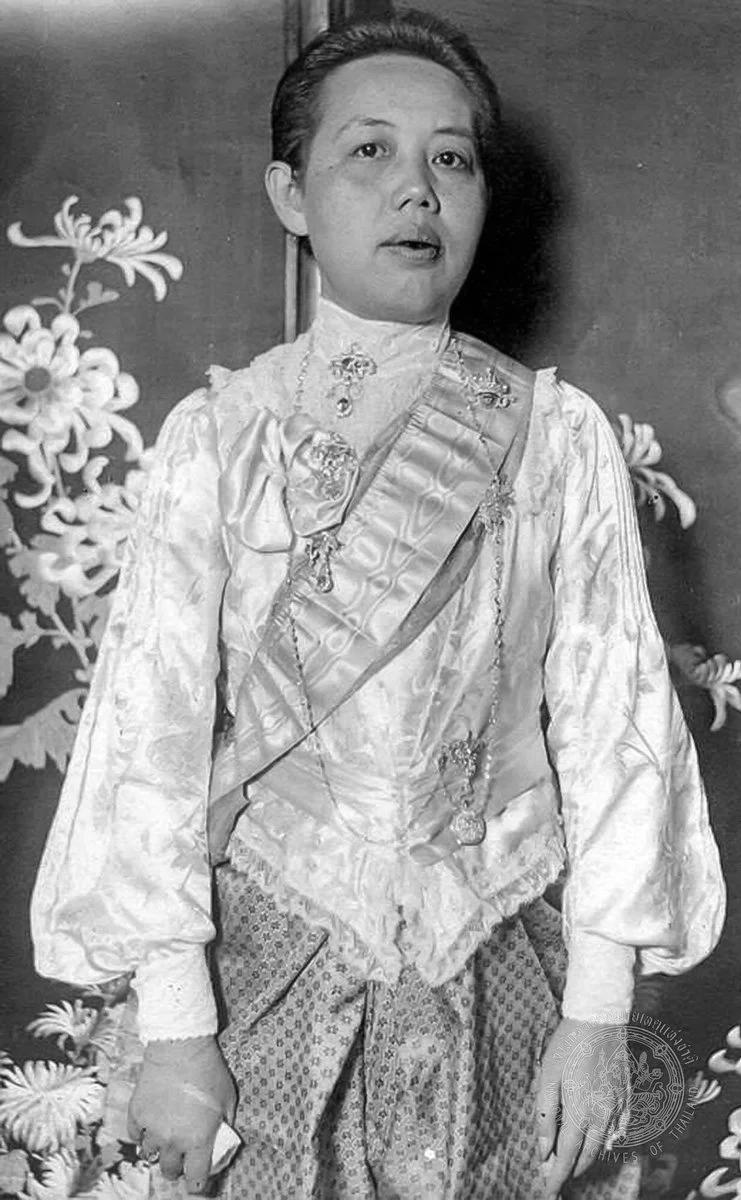สมเด็จพระศรีพัชรินทราบรมราชินีนาถ และทรงฉลองพระองค์ผ้าลูกไม้แบบแขนบิชอป
สมเด็จพระศรีพัชรินทราบรมราชินีนาถ และทรงฉลองพระองค์ผ้าลูกไม้แบบแขนบิชอป
ภาพนี้เป็นพระฉายาลักษณ์ที่ได้รับการบูรณะและสร้างสรรค์จากภาพถ่ายขาวดำต้นฉบับด้วยเทคโนโลยี AI เพื่อรังสรรค์ให้เห็นถึงฉลองพระองค์ของ สมเด็จพระศรีพัชรินทราบรมราชินีนาถ พระบรมราชินีนาถในรัชกาลที่ ๕ และ สมเด็จพระบรมราชชนนีพันปีหลวงในรัชกาลที่ ๖
ฉลองพระองค์ชุดนี้สะท้อนให้เห็นถึงความงดงามของ แฟชั่นสมัยเอ็ดเวิร์เดียน (Edwardian fashion) แบบราชสำนักสยามในปลายรัชกาลที่ ๕ ได้อย่างประณีตและสง่างาม เป็นยุคแห่งการเปลี่ยนผ่านที่ราชสำนักไทยรับเอารูปแบบการตัดเย็บแบบตะวันตกมาประยุกต์ให้สอดคล้องกับขนบธรรมเนียมไทยได้อย่างกลมกลืน
บริบททางประวัติศาสตร์แฟชั่น
ในช่วงปลายรัชกาลที่ ๕ (ประมาณ พ.ศ. ๒๔๔๘–๒๔๕๓) สตรีในราชสำนักสยามเริ่มนิยมฉลองพระองค์แบบยุโรป โดยเฉพาะ เสื้อลูกไม้แขนยาวและคอสูง (Edwardian blouse) ที่เน้นลวดลายละเอียดอ่อนของลูกไม้ ผ้าไหม หรือผ้าปักฉลุ ซึ่งสะท้อนรสนิยมแบบผู้ดีอังกฤษในยุคเอ็ดเวิร์เดียนได้อย่างสมบูรณ์
เสื้อลูกไม้แขนบิชอป (Bishop Sleeve)
ในพระฉายาลักษณ์นี้ สมเด็จพระศรีพัชรินทราบรมราชินีนาถ ทรงฉลองพระองค์ผ้าลูกไม้แบบแขนบิชอป (Bishop sleeve) ซึ่งเป็นลักษณะแขนเสื้อที่ได้รับความนิยมในช่วงต้นคริสต์ศตวรรษที่ ๒๐ หรือสมัยเอ็ดวอร์เดียน ต่อเนื่องจากแขนเสื้อทรงหมูแฮม (Leg-of-Mutton Sleeve) ของปลายยุควิกตอเรีย
1. แขนบิชอปมีลักษณะ พองตั้งแต่ช่วงข้อศอกลงมาถึงข้อมือ แล้วจึง จับจีบเข้าที่ปลายแขนด้วยแขนเสื้อ ทำให้เกิดลอนที่พองที่ปลายแขนอย่างอ่อนช้อย
2. ชื่อ “Bishop Sleeve” มาจาก แขนเสื้อของบาทหลวง (Bishop) ในชุดพิธีกรรมของศาสนาคริสต์ ซึ่งมีความพองและรัดปลายเช่นเดียวกัน
3. แขนเสื้อลักษณะนี้ช่วยเพิ่มความอ่อนโยนให้กับโครงเสื้อที่ยึดตาม คอร์เซ็ตรูปตัว S (S-bend corset) ซึ่งเป็นซิลลูเอ็ตต์ที่เด่นของแฟชั่นยุคเอ็ดเวิร์เดียน
เข็มขัดทรงตัววี (V-shaped Belt) และซิลลูเอ็ตต์แบบตัว S
นอกจากฉลองพระองค์เสื้อลูกไม้ที่อ่อนหวาน สมเด็จพระศรีพัชรินทราบรมราชินีนาถ ทรงคาดรัดพระองค์ (เข็มขัด) ทรงตัววี (V-shaped belt) ซึ่งปลายเข็มขัดด้านหน้าชี้ลงเป็นรูปตัว V ช่วยเน้นช่วงเอวและเสริมให้โครงคอร์เซ็ตแบบตัว S ดูสมส่วนยิ่งขึ้น เป็นเอกลักษณ์ที่พบได้ในแฟชั่นสตรีอังกฤษช่วงต้นคริสต์ศตวรรษที่ ๒๐
เมื่อประยุกต์เข้าสู่บริบทของสยาม พระองค์ยังทรง นุ่งโจงกระเบน ตามแบบราชสำนักไทย ทำให้เกิดการผสมผสานระหว่างเสื้อผ้าแบบตะวันตกกับเครื่องแต่งกายไทยได้อย่างกลมกลืน สะท้อนทั้งอิทธิพลของยุโรปและรากเหง้าทางวัฒนธรรมของสยาม
สำหรับนักออกแบบเครื่องแต่งกายหรือแฟชั่นดีไซน์ร่วมสมัย เวลาออกแบบเสื้อผ้าในยุคนี้ ควรจะใช้เข็มขัดทรงนี้เพื่อความถูกต้อง เพราะเวลาสวมคอร์เซ็ต เข็มขัดทรงตัว V จะใส่กระชับและลงตัวกับรูปทรงของคอร์เซ็ตได้อย่างสวยงาม
เครื่องราชอิสริยาภรณ์จุลจอมเกล้า และสายสะพายสองแบบ
อีกสิ่งหนึ่งที่น่าสังเกตคือ พระองค์ทรงประดับฉบองพระองค์ด้วย แพรปักเครื่องราชอิสริยาภรณ์จุลจอมเกล้า (Order of Chula Chom Klao) สองแบบ ซึ่งแสดงให้เห็นถึงพัฒนาการของวัสดุและเทคนิคการทอผ้าในยุคนั้น ได้แก่
1. แพรปัก (embroidered sash) — แบบดั้งเดิมในรัชกาลที่ ๕ ซึ่งเป็นผ้าปักดิ้นทองด้วยมือ ประณีตงดงามในเชิงหัตถศิลป์
2. แพรริ้วลายคลื่นนำ้ (moire silk sash) — แบบใหม่ที่ทอด้วยผ้าไหมลอนคลื่นตามแบบยุโรป หรือที่เรียกว่า moire pattern silk ซึ่งเริ่มใช้ในช่วงต้นคริสต์ศตวรรษที่ ๒๐
แพรสะพายทั้งสองแบบนี้จึงเป็นหลักฐานเชิงวัฒนธรรมที่สะท้อนการเปลี่ยนผ่านจากงานฝีมือช่างไทยดั้งเดิมสู่การรับเทคโนโลยีการผลิตสมัยใหม่ของตะวันตก
การผสมผสานระหว่างโลกตะวันตกและราชสำนักสยาม
ฉลองพระองค์ชุดนี้จึงเป็นสัญลักษณ์ของการหลอมรวมระหว่าง ความงามแบบตะวันตกและอัตลักษณ์ไทย อย่างกลมกลืน เสื้อลูกไม้แขนบิชอปและเข็มขัดตัววีแสดงถึงความร่วมสมัยและความสง่างามตามแบบผู้ดีอังกฤษ ส่วนโจงกระเบน แพรสะพาย และเครื่องราชอิสริยาภรณ์สะท้อนถึงเกียรติยศแห่งราชสำนักสยาม
สมเด็จพระศรีพัชรินทราบรมราชินีนาถ จึงทรงเป็นสมเด็จพระราชินีผู้ทรงเป็นแบบอย่างแห่งความสง่างามของสตรีสยามในยุคแห่งการปฏิรูปประเทศ พระฉลองพระองค์ชุดนี้ไม่เพียงแต่เป็นแฟชั่น หากยังเป็นสัญลักษณ์ของ ความทันสมัย ความเป็นสากล และพระปรีชาญาณในการธำรงอัตลักษณ์ไทยท่ามกลางกระแสโลกาภิวัตน์
_________________________________
Her Majesty Queen Sri Bajarindra and the Edwardian Lace Blouse with Bishop Sleeves
This image has been restored and reimagined from an original black-and-white photograph through AI technology, to recreate the attire of Her Majesty Queen Sri Bajarindra, Queen Consort of King Chulalongkorn (Rama V) and Queen Mother of King Vajiravudh (Rama VI).
This costume reflects the exquisite elegance of Edwardian fashion as interpreted within the Siamese royal court during the late reign of King Chulalongkorn. It marks a period of transition when Western tailoring was harmoniously adapted to Siamese court traditions with remarkable refinement.
Historical Fashion Context
During the late reign of King Chulalongkorn (circa 1905–1910), women of the Siamese royal court increasingly adopted European-style dress. The most distinctive element was the long-sleeved, high-necked lace blouse (Edwardian blouse) made of fine lace, silk, or embroidered voile — a perfect reflection of Edwardian upper-class taste and craftsmanship.
The Edwardian Lace Blouse and Bishop Sleeves
In this portrait, Queen Sri Bajarindra is depicted wearing a lace blouse with bishop sleeves, a style that became fashionable in the early 20th century during the Edwardian period, following the leg-of-mutton sleeves of the late Victorian era.
Bishop sleeves are full from the elbow to the wrist and gathered neatly into a cuff, creating a soft, graceful drape.
The term “Bishop sleeve” derives from the ceremonial robes worn by Christian bishops, whose voluminous sleeves gathered at the wrist in a similar fashion.
This sleeve style softened the rigid structure of the S-bend corset silhouette, the defining shape of Edwardian women’s fashion.
The V-Shaped Belt and the S-Bend Silhouette
In addition to the delicate lace blouse, Queen Sri Bajarindra wears a V-shaped belt — a fashion detail with the belt’s front point tapering downward into a V shape. This design accentuated the waistline and complemented the S-bend corset, producing the elegant forward-leaning posture typical of Edwardian style.
When adapted into the Siamese context, the Queen paired this Western blouse with the traditional chong kraben (โจงกระเบน), the draped lower garment of the royal court. The result was a graceful synthesis of Western modernity and Siamese heritage — a perfect visual metaphor for the cultural transformation of the era.
For modern costume designers and fashion historians, the V-shaped belt is an essential element for period accuracy, as it fits naturally and beautifully over an S-bend corset, completing the silhouette of the early Edwardian figure.
The Order of Chula Chom Klao and the Two Types of Sash
Another noteworthy detail is Her Majesty’s decoration of the Order of Chula Chom Klao, worn with two types of sashes (แพรสะพาย) — each representing an important stage in the evolution of royal regalia and textile craftsmanship:
Embroidered sash (แพรปัก) — the earlier hand-embroidered version from the reign of King Chulalongkorn, richly adorned with gold and silver thread.
Moire silk sash (แพรริ้วลายคลื่นน้ำ) — the newer European-style moire pattern silk, featuring a subtle wavy effect, which came into use in the early 20th century.
These two styles of sash symbolise the shift from traditional Siamese hand embroidery to modern woven silk, mirroring Siam’s broader embrace of technological progress during the period of modernisation.
The Fusion of East and West in the Siamese Court
This ensemble thus stands as a powerful symbol of the fusion between Western elegance and Thai identity. The Edwardian lace blouse and V-shaped belt embody refinement and sophistication inspired by European high fashion, while the chong kraben, royal sash, and decorations preserve the dignity and tradition of the Siamese monarchy.
Her Majesty Queen Sri Bajarindra was the epitome of grace and dignity — a true model of Siamese womanhood during the age of reform. Her attire represented not merely fashion, but the spirit of modernity, internationalism, and the wisdom to preserve Thai identity amid the currents of globalisation.
#aifashionlab #AI #aiartist #aiart #aifashion #aifashiondesign #aifashionstyling #aifashiondesigner #fashion #fashionhistory #historyoffashion #fashionstyling #fashionphotography #digitalfashion #digitalfashiondesign #digitalcostumedesign #digitaldesign #digitalaiart #ThaiFashionHistory #ThaiFashionAI #thailand #UNESCO





